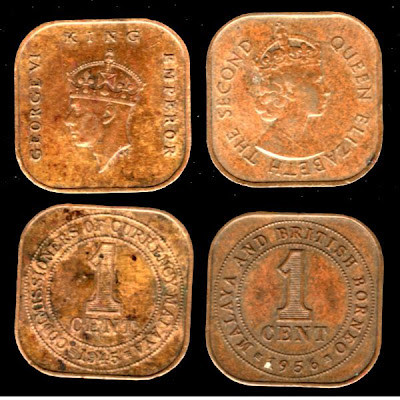
Recently Pos Malaysia issued a set of glow-in-the-dark stamps depicting six nocturnal mammals. Unfortunately I was out of town and didn't know when the first-day-covers came out. When I enquired at the post office a few days later they had all been sold out except for the Slow Loris and Tarsier. I was hoping to buy a Malay Badger or Teludu stamp, fortunately I was able to buy one off Ebay later!
Teledu (aka Teludu, Malay Badger, Stink or Skunk Badger) is a common animal on Borneo that's more often smelled than seen! Well, for this post I have reproduced an article that I wrote and which was published in the October 2004 issue of The Planter* Magazine:
My Introduction to Mr Teledu
My introduction to this guy was, to put it mildly, a very unpleasant affair. In fact it was quite a disaster!
It was in late '75 or early '76 when I was still quite new to hunting, which among us planters and their friends in those days meant driving around in a Land Cruiser at night laden with non-stop-talking-and-laughing people and a shotgun, shining a strong spotlight at the vegetation on either side of the road hoping to find an unfortunate quarry to shoot at. We were hunting for wild boar or deer in a cocoa plantation in Tawau when we spotted a cat-sized black and white animal on the roadside looking very much like acute little piglet!
"Stop!", I said and was out of the car in a flash and in front of the animal. It did not run so tried to catch it with my bare hands...but, before I could touch it, "Psssst!" and I was engulfed in a fine mist, like being sprayed with an aerosol can! "Yuuuuuaaack!", I screamed as I was overpowered by the foulest stink I had ever smelled in my life still not knowing what had hit me. The others in the car were equally ignorant and did not know what had happened but almost instantaneously the smell reached them in the vehicle! And everybody went "Arrggg!" and were making vomitting sounds!
It took quite a while for us to realise that some kind of skunk had used its weapon on me and that I had taken a direct hit mostly on the front of my shirt! Now there was a problem! My colleagues had a stinking person that they did not want to have as a passenger! I tried to get rid of the smell but even though I took off my shirt and threw it away I still smelled as bad as before. what I needed was a bath! So in the end I got my sIrirt back and they grudgingly let me ride home with them on the back of the Land Cruiser!
When I reached home (estate bachelor quarters) my dog barked at me and so did all the dogs in the neighbourhood. I rushed into the bathroom and tried to wash the smell off using up the whole 200-litre drum of water and almost a complete cake of toilet soap. But the smell still persisted though it was now much fainter and I could go to sleep. In the morning at dawn muster even though I could not smell anything (through my now desensitised nose) my colleagues looked at me curiously and the workers seemed to be avoiding me the whole day. I also washed my affected clothes, put them out in the sun and left them out day and night but the perfume still lingered even after one whole week! And the dog would still bark at the clothes if you showed them to him!
It was only after many years that I found out what that animal was. In those days there were no reference books on the local fauna at all, even if there were it would not have been available to the average person. All the while I had thought that I had had an encounter with a moonrat, an animal that was also reputed to possess an offensive stink. Today I would simply have to search the Internet with little clue-words like "smelly animal" and would have eventually found out that this terribly smelly animal was a Malay Badger aka Stink Badger or Mydaus javanensis! I even found some photos on the Net which reminded me of that night long ago!
Since then I have encountered Teledu countless times, mostly by smell. Sometimes at night you could just catch a whiff of his perfume in the air, sometimes it is so strong that all the dogs around barked and I know that some unfortunate victim (dog, maybe) had got a dose of what I got long long ago. I have also seen him when out hunting, but by now I knew better and always gave him a wide berth. I still hope to photograph him, alive and not as the roadkill that I often come across! When the wind is blowing in the right direction, I can sometimes smell a roadkill a kilometer before I see its crushed body on the road, and wonder whether the driver of the car was aware of what he had hit?

Recent photo of a dead Teledu on the road.
*Monthly magazine of the Incorporated Society of Planters in Malaysia.




















































